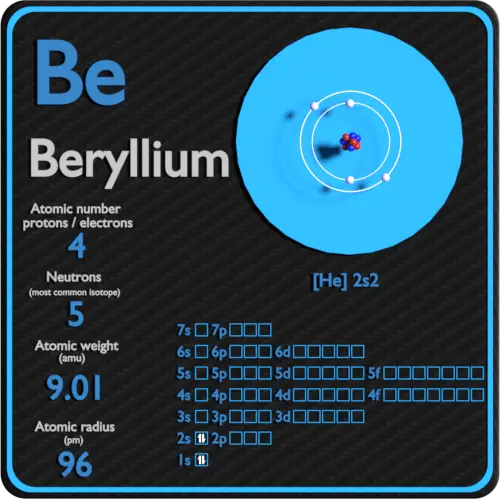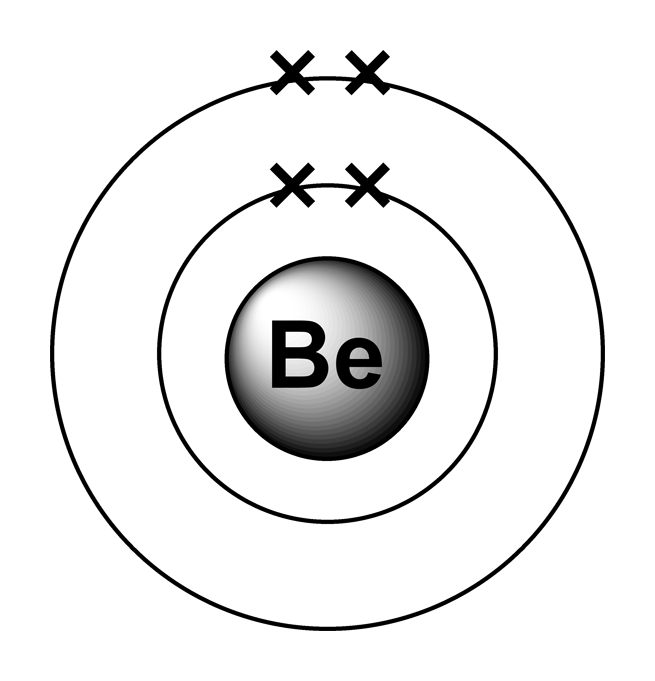Beryllium Number Of Electrons
Solution for 14. Which of the following is true regarding a neutral atom of beryllium? The number of protons is less than the number of electrons the number of. Beryllium is an alkaline earth metal, which places it in the second column on the periodic table. Beryllium's atomic number is 4. It is a fairly soft metal, but it's used to make alloys.
- Beryllium Number Of Electrons In Outer Shell
- How Many Protons In Beryllium
- Beryllium Number Of Valence Electrons



| General | |
|---|---|
| Symbol | 10Be |
| Names | beryllium-10, Be-10 |
| Protons | 4 |
| Neutrons | 6 |
| Nuclide data | |
| Natural abundance | trace |
| Half-life | 1.39×106 y |
| Spin | 0+ |
| Binding energy | 6497.6318 keV |
| Decay modes | |
| Decay mode | Decay energy (MeV) |
| β− | 0.5560[1][2] |
| Isotopes of beryllium Complete table of nuclides | |
Beryllium has two valence electrons. How many valence electrons does boron have? You must recognize that the second principal energy level consists of both the 2 s and the 2 p sublevels and so the answer is three. In fact, the number of valence electrons goes up by one for each step across a period until the last element is reached.
Beryllium-10 (10Be) is a radioactiveisotope of beryllium. It is formed in the Earth's atmosphere mainly by cosmic ray spallation of nitrogen and oxygen.[3][4][5] Beryllium-10 has a half-life of 1.39 × 106 years,[6][7] and decays by beta decay to stable boron-10 with a maximum energy of 556.2 keV. It decays through the reaction 10Be→10B + e−. Light elements in the atmosphere react with high energy galactic cosmic ray particles. The spallation of the reaction products is the source of 10Be (t, u particles like n or p):

- 14N(t,5u)10Be; Example: 14N(n,p α)10Be
- 16O(t,7u)10Be
Because beryllium tends to exist in solutions below about pH 5.5 (and rainwater above many industrialized areas can have a pH less than 5), it will dissolve and be transported to the Earth's surface via rainwater. As the precipitation quickly becomes more alkaline, beryllium drops out of solution. Cosmogenic 10Be thereby accumulates at the soil surface, where its relatively long half-life (1.387 million years) permits a long residence time before decaying to 10B.
10Be and its daughter product have been used to examine soil erosion, soil formation from regolith, the development of lateritic soils and the age of ice cores.[8] It is also formed in nuclear explosions by a reaction of fast neutrons with 13C in the carbon dioxide in air, and is one of the historical indicators of past activity at nuclear test sites.

See also[edit]
Beryllium Number Of Electrons In Outer Shell
| Lighter: Beryllium-9 | Beryllium-10 is an isotope of beryllium | Heavier: Beryllium-11 |
| Decay product of: lithium-11(β−, n) | Decay chain of beryllium-10 | Decays to: boron-10 |
How Many Protons In Beryllium
References[edit]
- ^'Decay Radiation: 10Be'. National Nuclear Data Center. Brookhaven National Laboratory. Retrieved 2013-10-16.CS1 maint: discouraged parameter (link)
- ^Tilley, D.R.; Kelley, J.H.; Godwin, J.L.; Millener, D.J.; Purcell, J.E.; Sheu, C.G.; Weller, H.R. (2004). 'Energy levels of light nuclei'. Nuclear Physics A. 745 (3–4): 155–362. doi:10.1016/j.nuclphysa.2004.09.059.
- ^G.A. Kovaltsov; I.G. Usoskin (2010). 'A new 3D numerical model of cosmogenic nuclide 10Be production in the atmosphere'. Earth Planet. Sci. Lett. 291 (1–4): 182–199. Bibcode:2010E&PSL.291..182K. doi:10.1016/j.epsl.2010.01.011.
- ^J. Beer; K. McCracken; R. von Steiger (2012). Cosmogenic radionuclides: theory and applications in the terrestrial and space environments. Physics of Earth and Space Environments, Springer, Berlin. Physics of Earth and Space Environments. 26. doi:10.1007/978-3-642-14651-0. ISBN978-3-642-14650-3. S2CID55739885.
- ^S.V. Poluianov; G.A. Kovaltsov; A.L. Mishev; I.G. Usoskin (2016). 'Production of cosmogenic isotopes 7Be, 10Be, 14C, 22Na, and 36Cl in the atmosphere: Altitudinal profiles of yield functions'. J. Geophys. Res. Atmospheres. 121 (13): 8125–8136. arXiv:1606.05899. Bibcode:2016JGRD..121.8125P. doi:10.1002/2016JD025034. S2CID119301845.
- ^G. Korschinek; A. Bergmaier; T. Faestermann; U. C. Gerstmann (2010). 'A new value for the half-life of 10Be by Heavy-Ion Elastic Recoil Detection and liquid scintillation counting'. Nuclear Instruments and Methods in Physics Research Section B: Beam Interactions with Materials and Atoms. 268 (2): 187–191. Bibcode:2010NIMPB.268..187K. doi:10.1016/j.nimb.2009.09.020.
- ^J. Chmeleff; F. von Blanckenburg; K. Kossert; D. Jakob (2010). 'Determination of the 10Be half-life by multicollector ICP-MS and liquid scintillation counting'. Nuclear Instruments and Methods in Physics Research Section B: Beam Interactions with Materials and Atoms. 268 (2): 192–199. Bibcode:2010NIMPB.268..192C. doi:10.1016/j.nimb.2009.09.012.
- ^Balco, Greg; Shuster, David L. (2009). '26Al-10Be–21Ne burial dating'(PDF). Earth and Planetary Science Letters. 286 (3–4): 570–575. Bibcode:2009E&PSL.286..570B. doi:10.1016/j.epsl.2009.07.025.
Beryllium Number Of Valence Electrons
